| |||||||
| Search Forums |
| Advanced Search |
| Go to Page... |
 |
| Search this Thread |  1,115,537 views |
| | #196 |
| Distinguished - BHPian  | Re: My Car Hobby: A lot of fiddling, and some driving too! Jaguar XJR, Mercedes W123 & Alfa Romeo Sp |
| |  ()
Thanks ()
Thanks
|
| |
| | #197 |
| Distinguished - BHPian  | Re: My Car Hobby: A lot of fiddling, and some driving too! Jaguar XJR, Mercedes W123 & Alfa Romeo Sp |
| |  ()
Thanks ()
Thanks
|
| | #198 |
| Distinguished - BHPian  | Re: My Car Hobby: A lot of fiddling, and some driving too! Jaguar XJR, Mercedes W123 & Alfa Romeo Sp Various little odd jobs over the weekend. I had another go at my broken Mini Maglite. I have ordered the LED upgrade kit, so it should be fully operational again in a few days. I also had a go at one of my two bicycles. This is my run around town bicycle. Lots of people in the Netherlands have at least two bicycles. One nice one to go touring and one old beat up one. For when you go into town. Bicycle theft is still rampant in the Netherlands. I have had this bicycle for many years. It is an Altra , a (what else) Dutch brand. It used to be black, but after some years it had some many scratches and dents I decided to re-paint it. It has drum brakes and a three speed Sturmey Archer. The rear wheel has been giving me some problems for some time. As if the brakes comes on now and then. So yesterday, on a very rainy gloomy Sunday I decided to take it apart to see what was going on. I have two large hooks in the beams across our garden shed for easy working on my bicycles.  Popped the rear wheel out, a 10 minute straight forward job.  Took the whole thing apart and it became very obvious something with one of the bearings was amiss. At lest 1/3 of the bearing balls were missing  So I stripped everything  I also found the inner casing in which the ball bearing run has developed two cracks, one very noticeable. I also found other metals bits and pieces, but I a not quite sure what parts they are. No wonder this thing was giving me some problems  I will take the wheel and the parts to a proper bicycle repair shop and see what they advise. I think it will need replacing Next I decided to flush the brake system on the Mercedes W123. I could not remember nor find any evidence in my maintenance record when that had been done for the last time. I have this cool gadget that supposedly can tell you the moisture content in the brake fluid.  According to my little gadget it was still only 1%, which should be fine. But I decided to go ahead and flush the system anyway.  Fired up my compressor  I have this vacuum bleeder that works really well. As usual always starts at the wheel with the longest brake line. In left hand cars that is usually the right rear. Then left rear, right front, left front. Such out the old fluid and then add new into the brake fluid reservoir and add the Special auto-filler canister on the brake fluid reservoir. 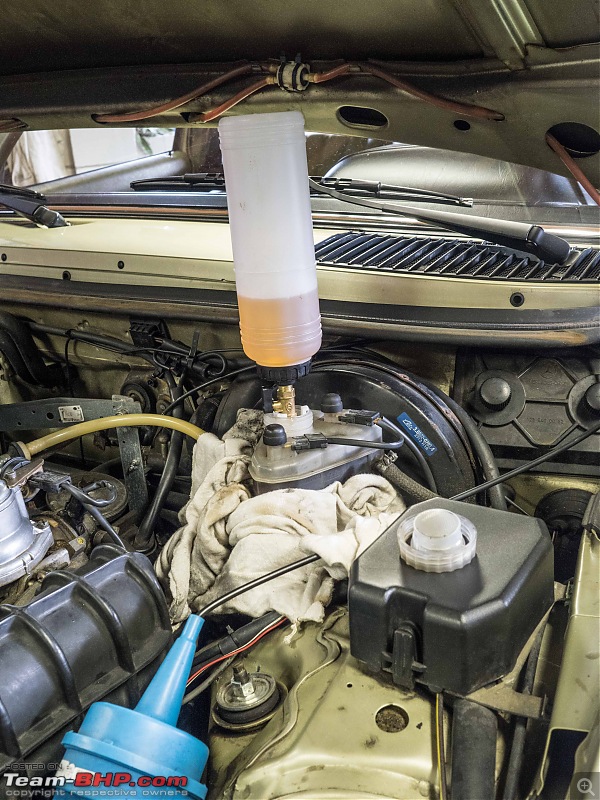 The vacuum bleeder in full operation  It is an easy enough job. The rear brakes takes much longer then the front ones. This thing works on creating a vacuum by means of compressed air being blown through a venturi. It would take about 10 minutes for the rear and 5 minutes for the front brakes. When I was done I put my foot on the brake pedal, just to check. Went straight to the bottom!! So something went wrong, somehow air made it into the system. Oh well, another job waiting Jeroen |
| |  (6)
Thanks (6)
Thanks
|
| The following 6 BHPians Thank Jeroen for this useful post: | digitalnirvana, Leoshashi, R2D2, rajathv8, Thad E Ginathom, vaasu |
| | #199 |
| Distinguished - BHPian  | Re: My Car Hobby: A lot of fiddling, and some driving too! Jaguar XJR, Mercedes W123 & Alfa Romeo Sp I was annoyed with myself for letting air into the brake system. So last night I set to work straight away to fix this. I also think I might know what has happened. The brake fluid reservoir on the W123 is divided into two parts. When you fill it only one half fills, the rear one, till it overflows into the second one, the front half. This is in case there is a leak in the system, only half the system will drain. A very simple and prudent design. The problem on the Mercedes reservoir is that you really need to fill the reservoir to almost the top before the fluid will actually overflow. As you can see in the previous images, my pneumatic bleeder comes with a simple auto-fluid filler bottle. It is just a bottle with a small valve and a small opening at the bottom. You insert it into the brake fluid reservoir and open the valve. It is just a small opening so as long as it is underneath the fluid level of the reservoir no fluid will drain from the bottle into the reservoir. But as you put vacuum onto the brake line, fluid is drawn through the master reservoir and the lines, meaning the fluid level in the reservoir drops and the auto filler bottle neck pops out of the receding fluid and starts replenishing until its below the reservoir level again. I think the auto-fluid filler bottle was inserted to deeply, meaning it started replenishing just as the fluid in the reservoir was about to spill from the rear into the front. So the front half of the reservoir was not filling properly. With hind sight an easy adjustment of the auto-fluid filler bottle. Anyway, just to finish the job quickly I decided to use my other brake fluid bleed system. The Easy Bleed. Here you see the filler bottle. Hooked up to the reservoir. Before filling it with new brake fluid it is always a good idea just to pressurise the system and see what happens first. Make sure the various connections are leak proof. The first time I used it on the W123 many, many years ago I did not. What I had not realised is that the hydraulic system for the clutch is fed with a simple hose from the brake fluid reservoir. There were no clamps on the hoses. So the hose popped off and sprayed brake fluid anywhere. Remember you are putting pressure on something that is supposed to operate under atmospheric pressure normally  The Easy Bleed is a DIY bleeder set to be used on the road. So it is pressurised by using the spare wheel. You do need to make sure that the tire pressure is wel below 1.5 bar.  Once you pressure test the system I use a large syringe to draw out most of the old fluid from the reservoir. Fill up the Easy Bleed bottle, pressurise the system and dive under the car, same sequence as before opening the bleed nipples one by one.  I catch the old brake fluid in a simple glass jar. I use a valve of one of my bicycle tires to ensure no air can enter back into the system. Very simple, very effective.  Any fluid left in the Easy Bleed bottle is uncontaminated and I pour it back in the original container for re-use. I write the date of opening on the bottle. After half a year or so, I do not use it anymore. The problem with brake fluid being it attracts moisture. So once you have broken the seal on a brake fluid canister use it or loose it. But I figure a couple of months should be alright.  Lastly, as this is a pressurised way of bleeding the system, the brake fluid reservoir fills to the brim. So when you are done, you need to extract some fluid as it will be filled well above the max level.  This system works really well. Obviously, it is depending on having a spare tyre. My experience is that with the tyre pressure reduced to 1.5 bar that is usually enough to push two fillings of the Easy Bleed bottle into the system, which should be enough. I also quickly bled the clutch hydraulics as well. Happy to report that the brake pedal is again working normally! I also took my bicycle wheel to a bicycle repair shop. As I was expecting the hub is really damaged beyond repair. Can not get a new wheel. The combination of a three speed and drum brakes is very rare. Nobody seems to use that anymore. It would also cost a lot, at least Euro 150 for a complete new set. This is an old bicycle. I like it and I like to keep it running mainly for sentimental reason. When we moved back from the UK to the Netherlands in 1986 my dad bought me this bicycle as a welcome back home present. I am going to try and make an improvised repair with a simple roller bearing. Which means I need to fabricate some sort of bushing to hold it in place. I know how to do that, but I do not have a lathe or mini mill. Time to get me one, but I might try a mate of mine first. Jeroen |
| |  (6)
Thanks (6)
Thanks
|
| The following 6 BHPians Thank Jeroen for this useful post: | digitalnirvana, Leoshashi, R2D2, Thad E Ginathom, wbd8779, ysjoy |
| | #200 |
| Distinguished - BHPian  | Re: My Car Hobby: A lot of fiddling, and some driving too! Jaguar XJR, Mercedes W123 & Alfa Romeo Sp Managed to make some progress on fixing my bicycle. I have ordered a SKF roller bearing, for those in the know, 61802-2RSI. This means it is pretty well sealed and is suitable for axial and radial loading. So I figure that will do. The outer diameter is 24mm and the inner diameter 15 mm. Which means I need two bushes. Went to my local friendly bicycle shop to ask for some advice and see what they had. I found a filler bush for a saddle pin. It is too large, but it is 0,5 mm thick and if I wrapped that around the bearing it becomes 25 mm and that will be a perfect fit. The inner diameter is a bit more tricky. It is the actual axle and has thread on it. Ideally I want a bush with inner thread and an outside diameter of 15 mm. Luckily my local bicycle specialist had something that I can get machined in the correct shape!! So took the rest of the inner bits apart!  Carefully more and more comes apart. I take images of the various stages and I had taken a couple of measurements too. This sort of stuff looks deceptively easy and simple when taking it apart. But every part needs to go back in, correct sequence and correct orientation.  First time I made use of my special cleaning tank! Works a treat, very pleased with it! 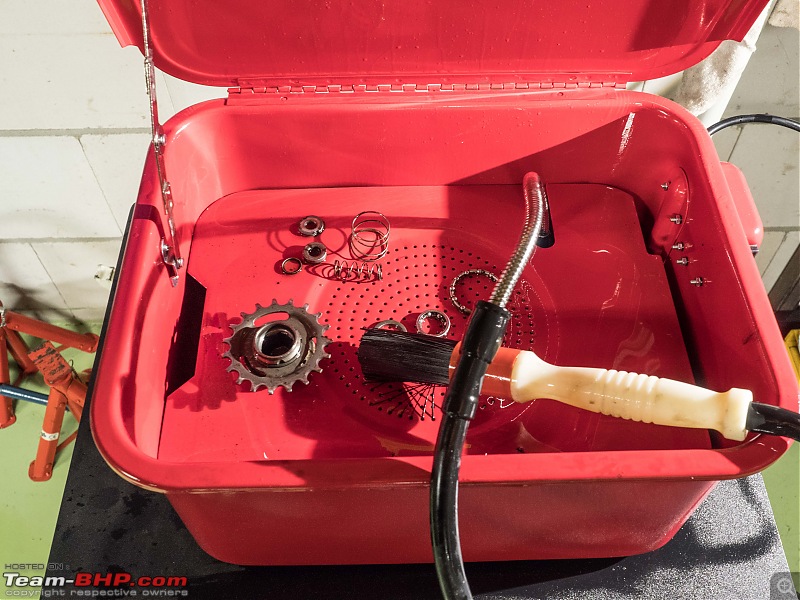 Everything pretty clean. You really need to work in a clean environment when you start putting everything back together again. 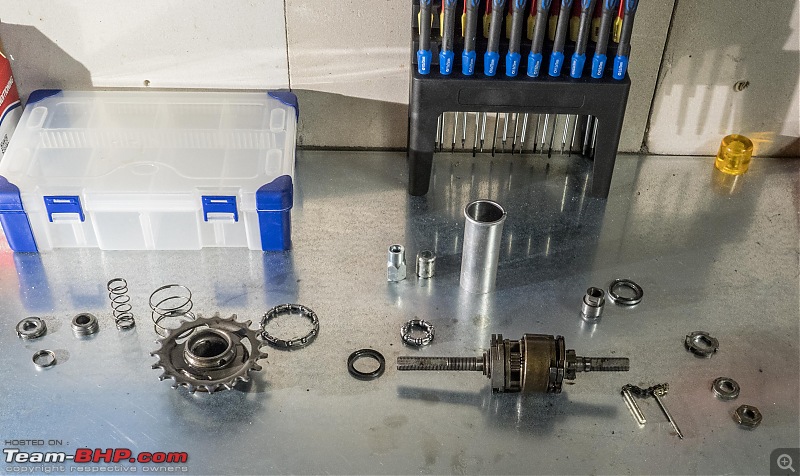 Carefully drying all parts, some needed another dip in my cleaning tank. Some more agitation of all the dirt with the special brush. But finally everything is ready. On the far right you can see the filler bush for the saddle pin. (large aluminium bit) A need to saw that into the correct size/shape. You can also see the other bushing that will need machining at the back.  The one part that did not go in the tank is the complete brake assembly. That would ruin the brake pads. So that got just cleaned with a brush and a cloth. I put it away in a plastic sealed bag until itís time to install. Mounting everything will require copious amount of oil and grease. Brake pads, oil and grease do not mix well together! My friendly bicycle specialist advised me to just use normal cycle chain oil on the innards of the gearing. So I applied that liberally and mounted the bearings on the sprocket side with normal bearing grease. This is all done, runs very smoothly. Gears appear to be working. So now I will have to wait for the roller bearing to arrive. I have already found a small machine shop in the next village that might help me machine the bushing. If anything I have a mate of mine on standby that could this at his work place. |
| |  (6)
Thanks (6)
Thanks
|
| The following 6 BHPians Thank Jeroen for this useful post: | digitalnirvana, R2D2, vaasu, vb-saan, VivekCherian, ysjoy |
| | #201 |
| Distinguished - BHPian  | Re: My Car Hobby: A lot of fiddling, and some driving too! Jaguar XJR, Mercedes W123 & Alfa Romeo Sp Today the LED upgrade for my MagLite arrived. Euro 13 which is not too bad. Comes into a nice sturdy plastic tube.   Very simple. Installing it is similar to replacing the bulb. You unscrew the top and stick it in..   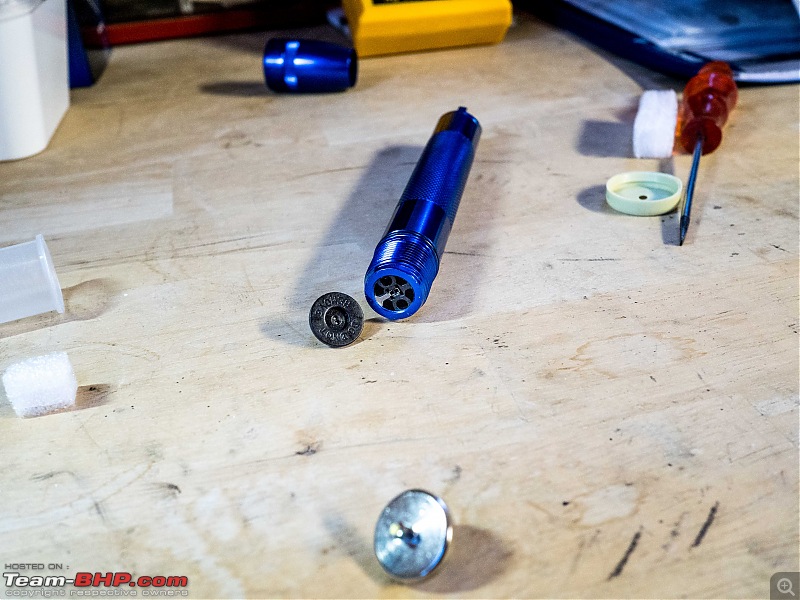 But here is the thing. I had not managed to get this MagLite going yet. And I must admit it has me baffled. And I mean completely baffled. Here is what MagLite calls the switch. It is essentially a base plate with two contacts. The bulb or LED is inserted with its two pins on one side. The bottom has a contact to which the plus of the battery pushes. The other contact wraps around the base plate and touches the torch casing. When you screw in the top it pushes the contact away from the casing. It does not get any simpler.   You need a long thin screw driver (a skewer will do to) to insert the base plate / switch back into the casing.  But whatever I tried I could not get this thing to light. I took my multi meter to it. Measured the correct voltage on the base plate, but when I insert the bulb or the LED nothing happens. Checked the bulb, measured resistance, hooked it up to the batteries with some wires, works fine. I took the batteries, line them up, pushed the base plate / switch against it and used a wire instead of the casing. The bulb lights up beautifully. But as soon as I install everything it does not work anymore. So something is wrong.  It is winter here in the Netherlands and it is very cold. In fact it is freezing and inside my garage the temperature was around 2oC. So I just had to give up after half an hour. My fingers were going numb! Also my SKF bearing for my bicycle arrived: 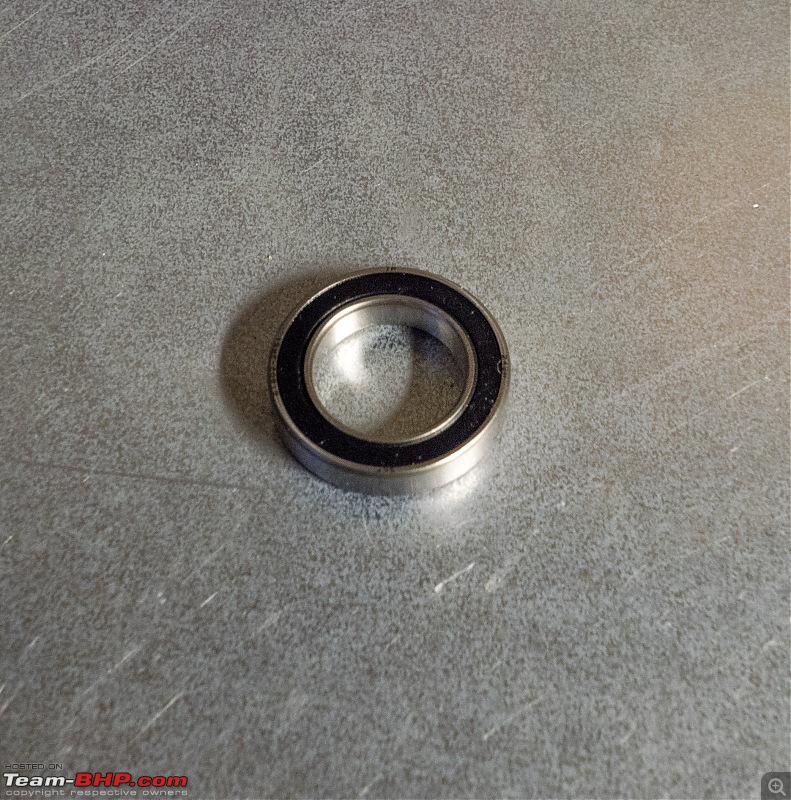 The filler bush I bought earlier this week is not the correct size. It’s 1mm thick and I need 0.5 mm so I ordered a different one. Next week I hope to get the parts machined and I can finish the bicycle. And I have to get to the bottom of the flippin MagLite. Very frustrating! Jeroen Last edited by Jeroen : 31st January 2019 at 23:07. |
| |  (4)
Thanks (4)
Thanks
|
| The following 4 BHPians Thank Jeroen for this useful post: | digitalnirvana, R2D2, vaasu, VivekCherian |
| | #202 |
| Distinguished - BHPian  | Re: My Car Hobby: A lot of fiddling, and some driving too! Jaguar XJR, Mercedes W123 & Alfa Romeo Sp I finally managed to get my MagLite going, with the LED upgrade. The problem was in the base of the torch. The spring that pushed the battery upwards sits in the base. It was corroded on the inside. Cleaned it and everything was fine. Spend several hours fiddling with all sorts of little odd jobs. The MagLite, fixed the door on the shed, as it was loose, fixed a window, fiddled with my scope a bit (still not working properly), fixed a clock, cleaned the garage floor. Happy Sunday afternoon. Jeroen |
| |  (2)
Thanks (2)
Thanks
|
| The following 2 BHPians Thank Jeroen for this useful post: | digitalnirvana, Thad E Ginathom |
| | #203 |
| Distinguished - BHPian  | Re: My Car Hobby: A lot of fiddling, and some driving too! Jaguar XJR, Mercedes W123 & Alfa Romeo Sp Today I popped over to see this local machine shop I had found. Just a few kilometers along the dike from where we live. Nice little shop. Owner and two guys. All my age. Asked them a bit about their shop, what kind of jobs they did. I told them about my bicycle being a gift from my dad more than 30 years ago and that I could not get spare parts and wanted to fix the bearing in a different way. I had brought the roller bearing and the bushing the local bicycle shop had given to me last week. Just needed turning down to 15 mm so it would fit in the bearing. They told me to leave it and come back this afternoon. Sure enough it was ready and they did not charge me a penny! Nice guys. So here are the essential bits I had to find/buy/was given. The large spacers are actually spacers to fit saddle pins. You can see the new roller bearing, behind it the machined bushing  I bought those saddle pin spacer, because they were the correct diameter and thickness to make into an outer spacer for the bearing. Put it around a piece of wood, careful measuring and then the hack saw 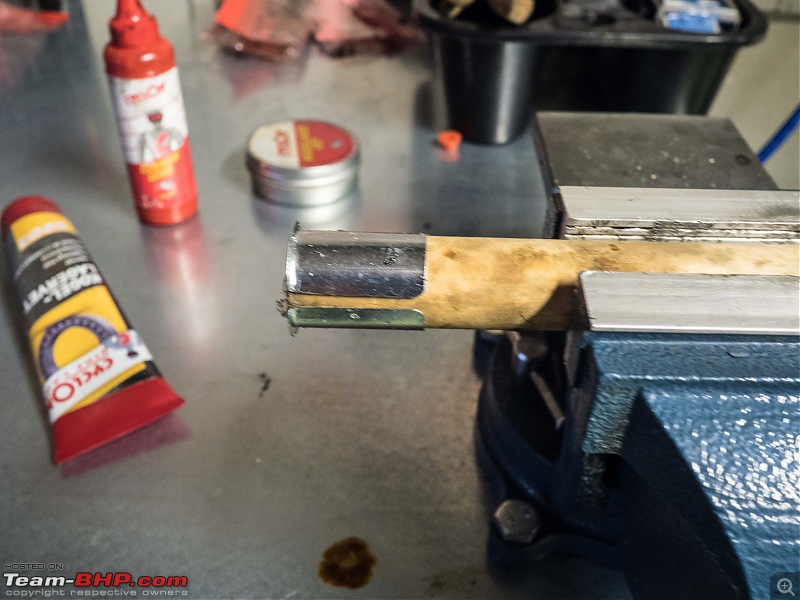 Voila, one perfect spacer, 4 mm wide, 0,5mm thick, 26mm diameter to fit into a 25mm hub. 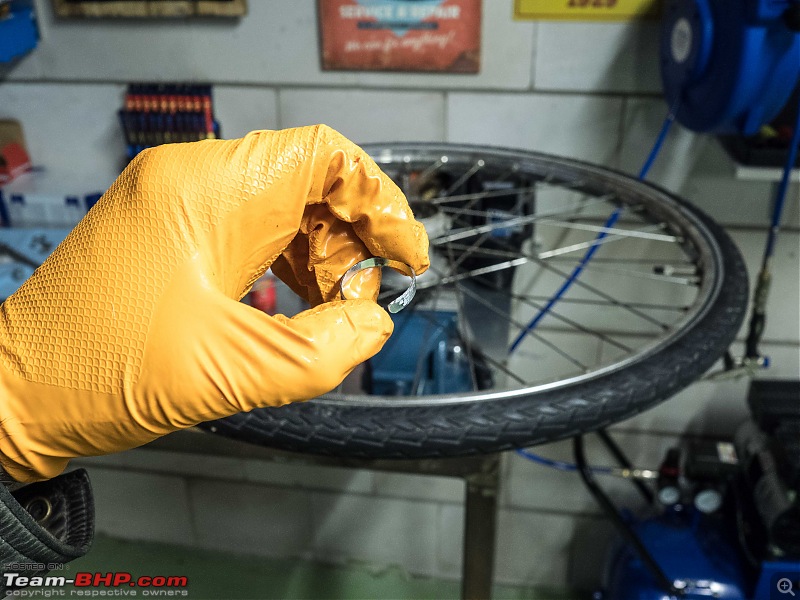 Put my new little Dremel to some good use too.  Here you can see the spacer I just cut fitted into the hub of the wheel.  Makes for a perfect fit with the outer casing of the bearing. Had to hammer it in place. Used a socket with the exact same outside diameter as the bearing. Worked a treat.  Next to create a similar nice snug fit on the inner casing of the bearing. This is where my freshly machined bushing comes into play. More measuring and I carefully cut of a 4mm piece.  As I said earlier, this bush has the correct thread inside, so it just screw onto the axle right into the bearing. Some more bits, spacers and rings had to be made and adjusted for, but the new bearing is fitted, snug as a bug!!  Getting the brake assembly back in place to some more measuring, grinding and filing down some parts in order for it to fit properly  Brought the bicycle in from our garden shed. It is much easier to work on it in my garage then in the shed. Also notice the air heater I have got going. When I started working tonight the temperature in my garage was just under 4oC. With the heater blasting away the temperature was well above 7oC within an hour. Those few degrees make a huge difference!  Some more final adjustment on the wheel before it goes back into the frame  The gear shifter had taken a beating some time ago. I think the bicycle fell over and it hit something. Nothing a tie-wrap can not fix! 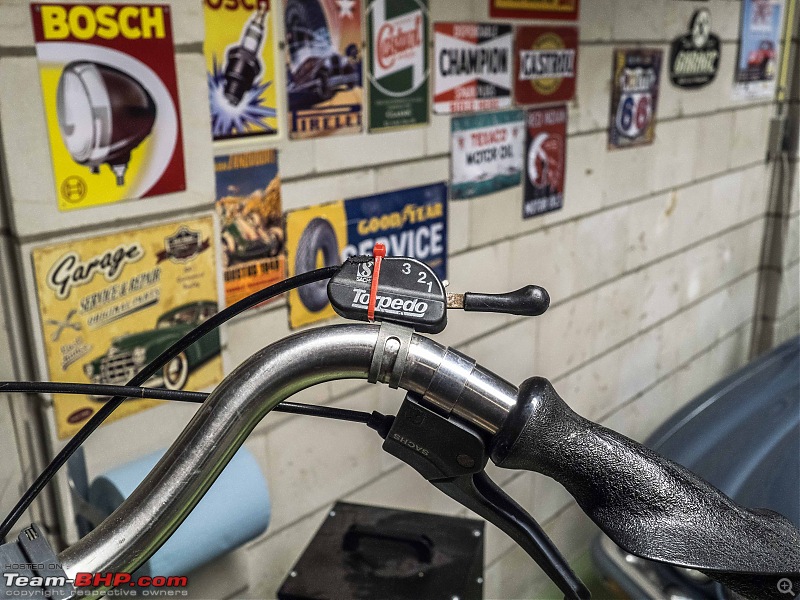 All done!! 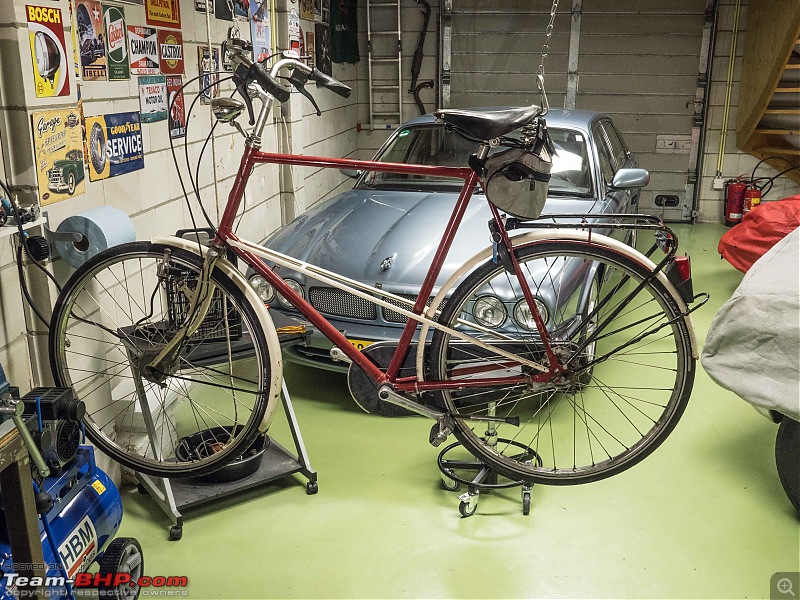 It took the bicycle for a short test ride on our dike in the dark. Wheel runs very smoothly, no noises, all three gears work perfectly, both brakes are working and the front and rear light are working of the dynamo on the front wheel. Very happy, very satisfying to accomplish these sort of jobs. My dad would have been proud of me! Good fun too. Takes quite a bit of improvisation. Wish I had a mini mill and lath. But when I told my wife the local machine shop had not charged me, she told me: Good, keep going back to them, much cheaper than getting more tools and making your own. Let them do it. So I need to come up with some new arguments why I absolutely need to have some proper machining tools! Jeroen Last edited by Jeroen : 6th February 2019 at 02:23. |
| |  (8)
Thanks (8)
Thanks
|
| The following 8 BHPians Thank Jeroen for this useful post: | blackwasp, digitalnirvana, R2D2, srishiva, Thad E Ginathom, vaasu, VivekCherian, ysjoy |
| | #204 |
| Distinguished - BHPian  | Re: My Car Hobby: A lot of fiddling, and some driving too! Jaguar XJR, Mercedes W123 & Alfa Romeo Sp Finally got around to fix the hood of the Spider. Earlier I noticed a tiny tear in the plastic window. Now I am not that bothered by the state of the hood at all. Remember I always, and I mean always, drive my Spider top down. Rain, snow, sleek, fog always. Once all the way up to the Northpole in Norway at -27oC. However, when we are touring the Spider tends to stay overnight outdoors, so the hood needs to be as watertight as can be. Here you see the tiny tear. It is about 3-6 mm only. Sorry for the poor quality of the image, it is very difficult to capture this.  First thing was to drill a hole (1.5mm) at the end of the tear. This, so is the theory, at least prevent it from tearing any further. There is a lot of tension on the hood and the plastic window when it is up.  Next I found a piece of plastic that sort of felt similar to the texture of the window. Used the same glue as I used to fix a patch on an inner tube of a bicycle tyre. Seem to do the trick.  Looks alright, or at least it will prevent water from seeping through. I also ordered four new tyres for the Mercedes W123. I realized the other day I had these tyres for quite some time. I checked the rear one for a date stamp and that showed 2011. Not to bad. But then when I remember I only had the rear ones swapped at the time. So back to the garage and checked the front ones, 2008! There is nothing wrong with these tyres, plenty of thread left. This car does not do much mileage. And between 2009 and 2016 I was abroad and it probably did less than 1000 km. But tyres do wear due to age. The changes of them bursting is remote, but older tyres have a noticeable effect on the comfort of the ride and more importantly, the road holding. So I decided to get them all replaced. Orderer four Good Year Vector 4 Seasons G2. It had good reviews, it is supposed to have very good performance when wet and less noise. Ordered them online, will get them fitted this Saturday. Jeroen |
| |  (6)
Thanks (6)
Thanks
|
| The following 6 BHPians Thank Jeroen for this useful post: | blackwasp, digitalnirvana, R2D2, Thad E Ginathom, vaasu, VivekCherian |
| | #205 |
| Distinguished - BHPian  | Re: My Car Hobby: A lot of fiddling, and some driving too! Jaguar XJR, Mercedes W123 & Alfa Romeo Sp As of 1st of March my Alfa Romeo Spider and the Mercedes W123 are allowed back on the public road! So I had a nice weekend. First thing last Saturday was to get four new tyres fitted to the Mercedes. For the first time ever I ordered them online. I had gotten a tip from a mate about this really good Internet website. (https://www.autobanden-365.nl ) All in Dutch I am afraid. But they do just about any kind and brand of tyre. Really good prices. I checked with a few other places, the typical quick fitters and so. But these were a lot cheaper. You order them and have them delivered to a fitting centre of your choice. They have more than 600 of these independent tyre fitters around the Netherlands. There were 5 within a 10-12 km radius from us. I choose the cheapest. You order and pay the tyres online, then have them delivered to your fitting centre, make an appointment and they fit them and you just pay them a small charge for the fitting. In all I save about Euro 100 on four tyres compared to Kwikfit and Euromaster. Also had the spare tyre replaced with the best of the old tyres that came off. Nice place. It looks very professional, but it is essentially a guy who is doing this as sort of a hobby. He is only open two days a week. Nice guy, had a long chat with him. Another customer with a 1983 Range Rover joint us too, so a lot of car talk on the Saturday morning. Here you see my W123 on the lift. Took all but one hour to change 5 tyres.   Next, I took the W123 on its new tyres for its first drive of the year. I headed for Antwerp. This weekend they had a nice Classic car Show. It is just an hour’s drive from where we live. All motorway. Here I am cruising along on the motorway, passing the Dutch-Belgium border doing well over 100 km/h. This is the EU, there are no borders! You just thunder on!  Just a few images of the Classic Car event in Antwerp. Every year they have a theme. Guess what the theme was this year?  These cars are quite unusual, love the shape! Absolutely gorgeous!  Even on Classic Car events you might bump into the occasional modern car. Not quite sure what the story is, probably because it is based on a true legendary classic car and for that reason alone it is a classic in the making. When I win the lottery I am definitely getting me one of these! Renault Alpine, fantastic car 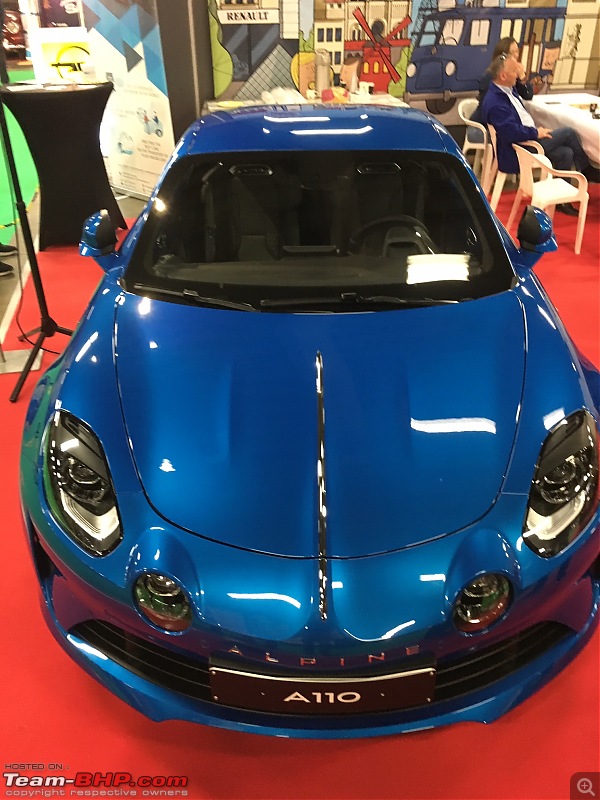 Ever wondered what a Citroen 2CV engine looks like. Wonder no more, here is one we took out a 2CV earlier  My own Dutch Alfa Romeo Spider Register always has a booth on this event as well. Nice to visit them, catch up with the other members. We had a similar Spider Touring 2600 on our booth from one of our members. This one was on display in another hall. All to be had for a mere Euro 185.000. Which is totally ridiculous. I checked with spanner mate and professional classic car valuer Peter. At least Euro 35-55.000 too much. It must be way too much as it was for sale last year with this company as well. Have not managed to shift it yet.  As we have now moved to rural the Netherlands I am trying to convince my wife we need a classic tractor. This one would do nicely. And we could claim we own a Lamborghini too!  I put it out on Facebook. All my friends liked it, but my wife veto-ed it. Bought myself some sign for my garage too.  Jeroen Last edited by Jeroen : 3rd March 2019 at 14:36. |
| |  (7)
Thanks (7)
Thanks
|
| The following 7 BHPians Thank Jeroen for this useful post: | digitalnirvana, R2D2, satan's_valet, Thad E Ginathom, vb-saan, VivekCherian, ysjoy |
| | #206 |
| Distinguished - BHPian  Join Date: Jun 2007 Location: Chennai
Posts: 11,435
Thanked: 29,974 Times
| Re: My Car Hobby: A lot of fiddling, and some driving too! Jaguar XJR, Mercedes W123 & Alfa Romeo Sp The Alpine looks seem to have been somewhat reincarnated in the modern Volvo! There was a Sunbeam Alpine, I seem to recall. My mental picture is vague now, but it was a lovely car. Any relative? . Last edited by Thad E Ginathom : 3rd March 2019 at 17:26. |
| |  ()
Thanks ()
Thanks
|
| |
| | #207 | |
| Distinguished - BHPian  | Re: My Car Hobby: A lot of fiddling, and some driving too! Jaguar XJR, Mercedes W123 & Alfa Romeo Sp Quote:
https://en.wikipedia.org/wiki/Alpine_A110 Have a look at some images old and new: https://www.google.com/search?rls=en...w=1440&bih=837 The new one is a serious bit of kit and in no way relates to Volvo or Sunbeam. It has had fantastic reviews just about anywhere. https://www.topgear.com/car-reviews/alpine/a110 It did have one bit of problem. One went up in flames. But that was just bad luck. I would love one! I will have to try it for size. I would not fit into the old one. My old next door neighbour had one of the original A110. He used it extensively for classic rallying. I tried several times, but there was no way I could slide in the drivers seat! Jeroen | |
| |  (3)
Thanks (3)
Thanks
|
| The following 3 BHPians Thank Jeroen for this useful post: | digitalnirvana, R2D2, Thad E Ginathom |
| | #208 |
| Distinguished - BHPian  | Re: My Car Hobby: A lot of fiddling, and some driving too! Jaguar XJR, Mercedes W123 & Alfa Romeo Sp Last weekend a friend and I visited the British Cars and Lifestyle exhibition. This one has been going on for many years. Just a thirty minute drive from where we live. Picked up my friend on the way there. Obviously, only one car to take to this event, my Jaguar XJR! We spend a couple of hours roaming around the various market stalls and display. Here is an impression from 2016. But this is one event that doesnít change much year over year. Same lay-out, same exhibitors. It is a good mix of club and commercial enterprises. In essence the commercial enterprises sponsors the clubs to be there. As a club you pay a small fee to be present. Just more impressions from my iPhone: 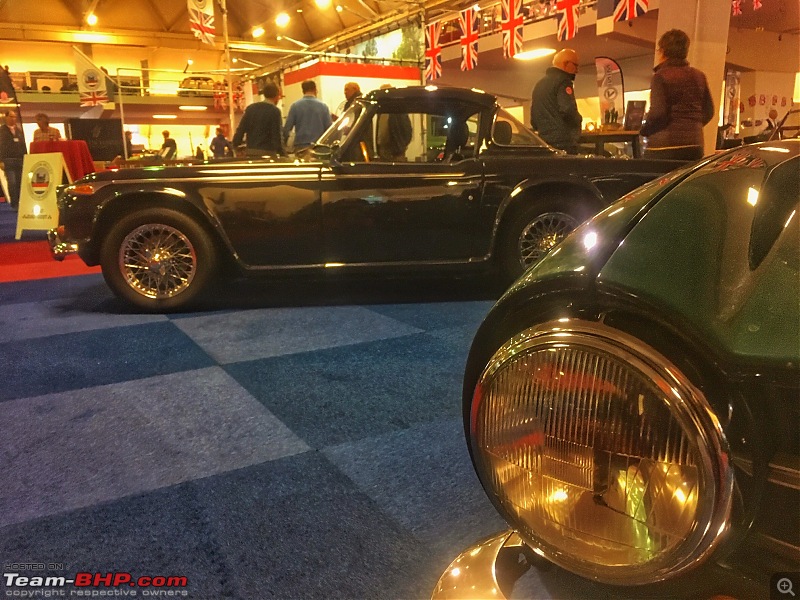   This is both a car AND a lifestyle event. It is probably the car event with the highest gender diversity. It is the one car event where you will see a large number of couples, rather than just the guys. Got myself a few very nice sign to add to my ever increasing collection!  Not much work to be done on the cars. All in good working order, touch wood!! My son has just ordered the new exhaust for his Golf. Earlier we had discovered it was completely rusted through, see some earlier post. The parts are expected some time next week. Should be a fairly straight forward job. Although you never know on exhaust. Fitting them can be a bit of a problem. We will see. We will also have another go at his ever illusive speed sensor problem. We have spend considerable time on it. I really need to get my hands on a proper VAG diagnostic kit. That would help considerable to verify which signals are working properly. Even my best OBD scanner/analyser wonít do that on a VW. Jeroen |
| |  (6)
Thanks (6)
Thanks
|
| The following 6 BHPians Thank Jeroen for this useful post: | digitalnirvana, R2D2, StarryFurry, vb-saan, VivekCherian, ysjoy |
| | #209 |
| Distinguished - BHPian  | Re: My Car Hobby: A lot of fiddling, and some driving too! Jaguar XJR, Mercedes W123 & Alfa Romeo Sp Last night I had another go at fixing the steering wheel on my Mercedes W123. Ever since I had the steering box overhauled/adjusted I somehow manage to fail to get the steering wheel properly centred. This is what it looked like going straight, on a straight, level motorway.  I find it incredibly annoying the steering wheel being off-centre! With 3-4 previous attempts the good news is that I am becoming very good at resetting the Steering Wheel position towards the Steering Box. Takes me 5-6 minutes. I have no idea, why I got it wrong so often, it is not a particularly difficult thing to do. Maybe I’m getting old (turned 60 today). Anyway the good news is that my latest little adjustment seems to have done the trick. Job done. Steering wheel properly centred! tonight I am attending a workshop on Classic Car electrical systems. No idea what to expect, but I am still looking forward to it. I will always pick up some new insights, tips and tricks and there will be lots of old forgetful gits like me talking old cars and endless spannering stories. Jeroen |
| |  (10)
Thanks (10)
Thanks
|
| The following 10 BHPians Thank Jeroen for this useful post: | Cyborg, deep_behera, digitalnirvana, R2D2, StarryFurry, Thad E Ginathom, The_Outsider!, vaasu, VivekCherian, ysjoy |
| | #210 |
| Distinguished - BHPian  | Re: My Car Hobby: A lot of fiddling, and some driving too! Jaguar XJR, Mercedes W123 & Alfa Romeo Sp Today the exhaust for my sonís Golf arrived. Luc ordered on line and had it delivered directly to us. Huge box! 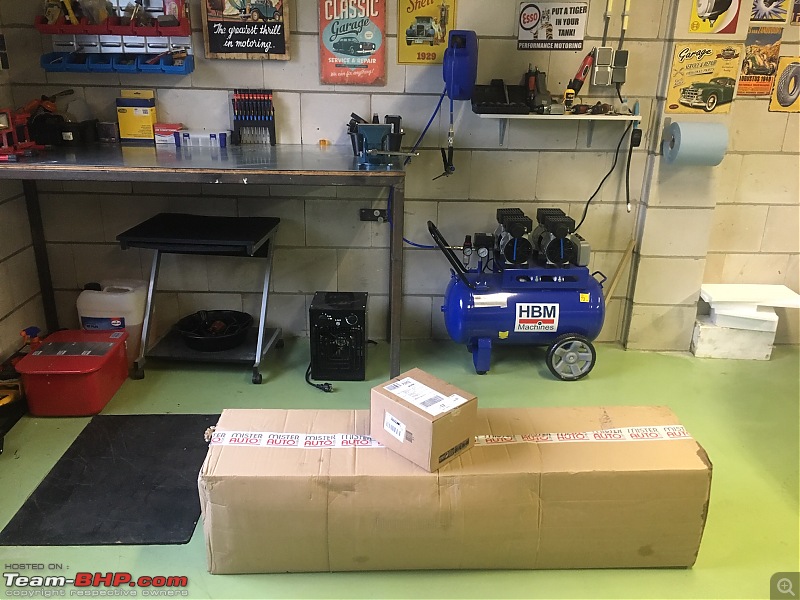 But as soon as I opened it, to inspect, there was a problem!  This thing is badly dented. I did notice that the two large flaps on the box were not well taped up and were flopping inwards. Not much bubble wrap and none on top of the exhaust.  I hate it when this happens. Luc will be contacting the suppler and see how we get this thing returned and exchanged asap. Jeroen |
| |  (3)
Thanks (3)
Thanks
|
| The following 3 BHPians Thank Jeroen for this useful post: | digitalnirvana, R2D2, Thad E Ginathom |
 |


